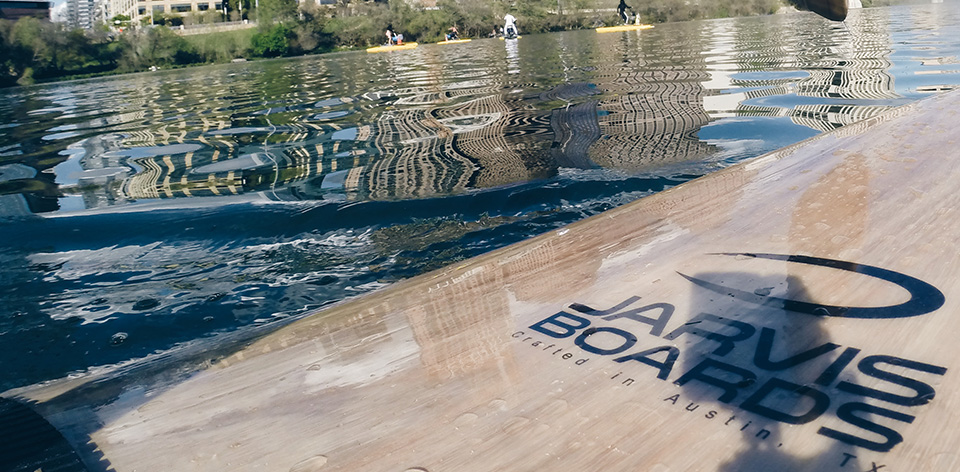Gear Call Out: Jarvis Boards

Q: When were you first introduced to the sport of paddleboarding?
A: I wish I could say there was some grand “ah ha” moment, but in all honesty paddle boarding was a natural progression. Over the years I’ve surfed, gone on canoe trips across the state of Texas, and sea kayaked along the gulf coast. The first time I tried paddle boarding I was like, “All right, it’s like all of those other things combined—except cooler. I was hooked.”
Q: What was your initial reaction when you first set foot on a paddleboard?
A: This is way easier than I thought it would be.
Q: How did Jarvis Boards get its start?
A: Jarvis Boards really began as an after-work passion project. A few years back, while working a day job in finance, I stumbled upon a how-to guide on building your own wooden canoe at a local bookstore. Inspired, I ordered a cheap table saw from Amazon.com, bought some wood at the local hardware store, and set out to build a wooden canoe. To everyone’s surprise—including my own—the canoe not only floated, but it looked amazing. Given this success, I set out to combine the canoe with efficient computer aided design to build a better SUP made from wood.
Q: You mentioned that you worked in finance. How does the end of a work day at Jarvis Boards compare to the end of a work day in the office?
A: When you own your own business there is no “end of a workday.” After you’re done building boards there are emails to be sent, website updates to be made, and collaborations and photo shoots to work on. Although finance is cool, at the end of the day, there isn’t a tangible thing you can point to and say, “I made that.” You spend so many hours working on and obsessing over every detail when building paddleboards that, when you’re done, there is this huge sense of pride and satisfaction.
Q: What type of wood do you use?
A: Depending on the board, we use a number of different wood types to minimize weight including balsa, cedar, paulownia, and reclaimed redwood.
Q: How long does it take to build one?
A: More hours than I care to admit. Because people in our community are spending their hard earned money on our products, we want to ensure that each board is as close to perfect as possible.
Q: What’s your favorite part of the design/construction process?
A: Because the boards are made of wood, and wood is a natural product, each board is truly unique with slightly differing wood patterns. These patterns really come to life near the end of the building process when the final layer of thin resin is added to protect the wood.
Q: Do you have a team that helps you?
A: For the last year and a half, we’ve operated out of a small co-op woodworking studio in East Austin. This space has been an amazing location as it is full of artisans and craftsmen who help in the production of the boards.
Q: Besides the fact that Jarvis Boards are made out of wood, what sets them apart from traditional paddleboards?
A: About 90 percent of the SUPs sold in the U.S. are mass produced overseas and imported to the U.S. We are proud to be making our boards right here in Austin and employing people in our community. Also, because of their wood structure, our boards are lighter than many competitor boards of the same size. They are also very durable—a function of the natural strength of wood fibers. This gives our boards very high impact resistance.
Q: Are they faster or slower?
A: Let’s race! In all seriousness, speed is a function of the hull design and less so the materials used. Our flat-water shapes are very fast and make great fitness, racing, and touring boards. They feature a dropped deck which helps make them feel more stable in the water. We also have designs made just for hanging out with the dog and family as well as surfing.
Q: Where do you find inspiration for new board designs?
A: I wish I could take all the credit, but a lot of the inspiration comes from the Austin community. We are fortunate to live in a city full of incredibly talented people and artisans who have helped Jarvis Boards immensely in pushing the boundaries of SUP board design.
Q: Why is Austin an ideal city for the sport of paddleboarding?
A: I feel paddleboarding is made for Austin and I think we’ve only scratched the surface of the sport. We have the perfect combination of a lot of fitness-minded people coupled with amazing water destinations within an hour drive of downtown. As more people transition from renting boards (primarily confined to Lady Bird Lake) to purchasing boards, I think they will come to realize how many amazing SUP destinations are so closeby. (Find a SUP destination guide at Jarvisboards.com.)
Q: Your favorite spot around town to refuel post-paddle?
A: Easy. Black Sheep Lodge is walking distance from my house and they have the best tater tots in the city. In the words of Toby Keith, “I love this bar.”






